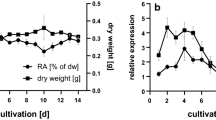Summary
-
1.
Cells and protoplasts were isolated from the tapetum in order to demonstrate the importance of this tissue in the phenylpropanoid metabolism of the anther loculus. It was our purpose to investigate the localization of the key phenylpropanoid enzyme, phenylalanine ammonia-lyase, within the tapetum and the other anther tissues.
-
2.
The isolation of tapetum protoplasts proved to be possible only from tissue of the early developmental stage, and even then only with difficulties. It was not possible to obtain enough protoplasts for enzymatical studies. The cell walls of the tapetum from later developmental stages contain components which resist the attack of the hydrolytic enzymes.
-
3.
Tapetum tissue, on the other hand, could be isolated in much greater quantities such that enzymatical studies were possible. Contamination of this isolated tissue with cells, protoplasts or traces of other anther tissues could not be detected.
-
4.
The anther tapetum showed a very high specific PAL activity, whereas the pollen and other anther tissues contained only marginal activity. This result illustrates the dominant role of the tapetum in the anther phenylpropanoid metabolism.
-
5.
IR-spectroscopy and acetolysis resistance revealed that sporopollenin is a building material of the newly formed tapetal and peritapetal cell walls.
Similar content being viewed by others
Abbreviations
- PAL:
-
Phenylalanine ammonia-lyase
- MES:
-
Morpholinoethanesulfonic acid
References
Ahokas, H., 1975: Male sterile mutants of barley II. Cytochemistry of non-mutant and msg 6 cf microspores and pollen. Heriditas81, 33–46.
Banerjee, U. C., 1967: Ultrastructure of the tapetal membrane of grasses. Grana Palynol.7, 365–377.
Banerjee, U. E., Barghoorn, E. S., 1971: The tapetal membrane of grasses and Ubisch body control of mature exine pattern. In: Pollen: development and physiology (Heslof-Harrison, H., ed.), pp. 126–127. London: Butterworths.
Bhandori, N. N., Kishori, R., 1973: Development of tapetal membrane and Ubisch granules inNigella damascena, a histochemical approach. Beitr. Biol. Pflanz.49, 59–72.
Dickinson, H. G., 1970: The fine structure of a peritapetal membrane investing the microsporangium ofPinus banksiana. New Phytol.69, 1065–1068.
Echlin, P., 1971: Production of sporopollenin by the tapetum. In: Sporopollenin (Brooks, J., Grant, P. R., Muire, M., van Gijel, P., Shaw, G., eds.), pp. 220–247. London-New York: Academic Press.
Erdtman, G., 1960: The acetolysis method. A revised description. Sv. Bot. Tidskr.54, 561–564.
Gupta, S. C.,Nanda, K., 1971: Membrane of anther tapetum in flowering plants. Proceedings of the 58th Indian Science Congress, Bangalore, Part III, pp. 499–500.
— —, 1972: Occurrence and histochemistry of the anther tapetal membrane. Grana12, 99–104.
Herdt, E., Sütfeld, R., Wiermann, R., 1978: The occurrence of enzymes involved in phenylpropanoid metabolism in the tapetum fraction of anthers. Cytobiologie17, 433–441.
Heslop-Harrison, J., 1969: An acetolysis-resistant membrane investing tapetum and sporogenous tissue in the anthers of certainCompositae. Can. J. Bot.47, 541–542.
—, 1975: The physiology of pollen grain surface. Proc. R. Soc. London B.190, 275–299.
Kleinehollenhorst, G., Behrens, H., Pegels, G., Strunk, N., Wiermann, R., 1982: Formation of flavonol 3-O-diglycosides and flavonol 3-O-triglycosides by enzyme extracts from anthers ofTulipa cv. Apeldoorn. Characterization and activity of three different O-glycosyltransferases during anther development. Z. Naturforsch.37 c, 587–599.
Lowry, O. H., Rosebrough, N. J., Farr, A. L., Randall, R. J., 1951: Protein measurement with the folin phenol reagent. J. biol. Chem.193, 265–275.
Reznickova, S. A., Willemse, M. T. M., 1980: Formation of pollen in the anther ofLilium II. The function of the surrounding tissues in the formation of pollen and pollen wall. Acta bot. Neerl.29, 141–156.
Sauter, J. J., 1969: Autoradiographische Untersuchungen zur RNS- und Proteinsynthese in Pollenmutterzellen, jungen Pollen und Tapetumzellen während der Microsporogenese vonPaeonia tenuifolia L. Z. Pflanzenphysiol.61, 1–19.
Stanley, R. G., Linskens, H. F., 1974: Pollen, Biology, Biochemistry, Management. Berlin-Heidelberg-New York: Springer.
Strack, D., Sachs, G., Wiermann, R., 1981: Pollen ofTulipa cv. Apeldoorn as an accumulation site of flavonol di- and triglycosides. Z. Pflanzenphysiol.103, 291–296.
Sütfeld, R., Wiermann, R., 1974: Über die Bedeutung des Antherentapetums für die Akkumulation phenylpropanoider Verbindungen am Pollen. Ber. dtsch. bot. Ges.87, 167–174.
—,Kehrel, B., Wiermann, R., 1978: Characterization, development and localization of “flavonone synthase” in tulip anthers. Z. Naturforsch.33 c, 841–846.
Wiermann, R., 1979: Stage-specific phenylpropanoid metabolism during pollen development. In: Regulation of secondary product and plant hormone metabolism (Luckner, M., Schreiber, L., eds.), pp. 231–239. Oxford-New York: Pergamon.
Author information
Authors and Affiliations
Rights and permissions
About this article
Cite this article
Rittscher, M., Wiermann, R. Occurrence of Phenylalanine Ammonia-Lyase (PAL) in isolated tapetum cells ofTulipa anthers. Protoplasma 118, 219–224 (1983). https://doi.org/10.1007/BF01281805
Received:
Accepted:
Issue Date:
DOI: https://doi.org/10.1007/BF01281805




